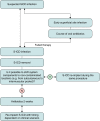Procedure, management, and outcome of subcutaneous implantable cardioverter-defibrillator extraction in clinical practice
- PMID: 37350404
- PMCID: PMC10288180
- DOI: 10.1093/europace/euad158
Procedure, management, and outcome of subcutaneous implantable cardioverter-defibrillator extraction in clinical practice
Abstract
Aims: Subcutaneous implantable cardioverter-defibrillator (S-ICD) therapy is expanding rapidly. However, there are few data on the S-ICD extraction procedure and subsequent patient management. The aim of this analysis was to describe the procedure, management, and outcome of S-ICD extractions in clinical practice.
Methods and results: We enrolled consecutive patients who required complete S-ICD extraction at 66 Italian centres. From 2013 to 2022, 2718 patients undergoing de novo implantation of an S-ICD were enrolled. Of these, 71 required complete S-ICD system extraction (17 owing to infection). The S-ICD system was successfully extracted in all patients, and no complications were reported; the median procedure duration was 40 (25th-75th percentile: 20-55) min. Simple manual traction was sufficient to remove the lead in 59 (84%) patients, in whom lead-dwelling time was shorter [20 (9-32) months vs. 30 (22-41) months; P = 0.032]. Hospitalization time was short in the case of both non-infectious [2 (1-2) days] and infectious indications [3 (1-6) days]. In the case of infection, no patients required post-extraction intravenous antibiotics, the median duration of any antibiotic therapy was 10 (10-14) days, and the re-implantation was performed during the same procedure in 29% of cases. No complications arose over a median of 21 months.
Conclusion: The S-ICD extraction was safe and easy to perform, with no complications. Simple traction of the lead was successful in most patients, but specific tools could be needed for systems implanted for a longer time. The peri- and post-procedural management of S-ICD extraction was free from complications and not burdensome for patients and healthcare system.
Clinical trial registration: URL: http://clinicaltrials.gov/Identifier: NCT02275637.
Keywords: Extraction; Implantable defibrillator; Infection; Subcutaneous.
© The Author(s) 2023. Published by Oxford University Press on behalf of the European Society of Cardiology.
Conflict of interest statement
Conflict of interest: R.R. received speaker fees from Abbot and Boston Scientific. L.O. is a consultant for Boston Scientific. P.F. received speaker fees from Boston Scientific and research or educational grants from Abbott and Boston Scientific. G.L.B. reports speaker fees (small amount) from Boston Scientific, Medtronic, Biotronik, Abbot, Microport, and Zoll. M.L. and S.V. are employees of Boston Scientific. The other authors report no conflicts.
Figures
References
-
- Boersma L, Barr C, Knops R, Theuns D, Eckardt L, Neuzil Pet al. . Implant and midterm outcomes of the subcutaneous implantable cardioverter-defibrillator registry: the EFFORTLESS study. J Am Coll Cardiol 2017;70:830–41. - PubMed
-
- Knops RE, Olde Nordkamp LRA, Delnoy PHM, Boersma LVA, Kuschyk J, El-Chami MFet al. . Subcutaneous or transvenous defibrillator therapy. N Engl J Med 2020;383:526–36. - PubMed
-
- Healey JS, Krahn AD, Bashir J, Amit G, Philippon F, McIntyre WFet al. . Perioperative safety and early patient and device outcomes among subcutaneous versus transvenous implantable cardioverter defibrillator implantations: a randomized, multicenter trial. Ann Intern Med. 2022;175:1658–65. - PubMed
Publication types
MeSH terms
Substances
Associated data
LinkOut - more resources
Full Text Sources
Medical



